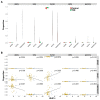An Efficient and Flexible Method for Deconvoluting Bulk RNA-Seq Data with Single-Cell RNA-Seq Data
- PMID: 31569701
- PMCID: PMC6830085
- DOI: 10.3390/cells8101161
An Efficient and Flexible Method for Deconvoluting Bulk RNA-Seq Data with Single-Cell RNA-Seq Data
Abstract
Estimating cell type compositions for complex diseases is an important step to investigate the cellular heterogeneity for understanding disease etiology and potentially facilitate early disease diagnosis and prevention. Here, we developed a computationally statistical method, referring to Multi-Omics Matrix Factorization (MOMF), to estimate the cell-type compositions of bulk RNA sequencing (RNA-seq) data by leveraging cell type-specific gene expression levels from single-cell RNA sequencing (scRNA-seq) data. MOMF not only directly models the count nature of gene expression data, but also effectively accounts for the uncertainty of cell type-specific mean gene expression levels. We demonstrate the benefits of MOMF through three real data applications, i.e., Glioblastomas (GBM), colorectal cancer (CRC) and type II diabetes (T2D) studies. MOMF is able to accurately estimate disease-related cell type proportions, i.e., oligodendrocyte progenitor cells and macrophage cells, which are strongly associated with the survival of GBM and CRC, respectively.
Keywords: cell-type compositions; deconvolution; gene expression; nonnegative matrix factorization; single-cell RNA-seq.
Conflict of interest statement
The authors declare that the research was conducted in the absence of any commercial or financial relationships that could be construed as a potential conflict of interest.
Figures





Similar articles
-
Deconvolution from bulk gene expression by leveraging sample-wise and gene-wise similarities and single-cell RNA-Seq data.BMC Genomics. 2024 Sep 18;25(1):875. doi: 10.1186/s12864-024-10728-x. BMC Genomics. 2024. PMID: 39294558 Free PMC article.
-
Transcriptome size matters for single-cell RNA-seq normalization and bulk deconvolution.Nat Commun. 2025 Feb 1;16(1):1246. doi: 10.1038/s41467-025-56623-1. Nat Commun. 2025. PMID: 39893178 Free PMC article.
-
Accurate estimation of cell composition in bulk expression through robust integration of single-cell information.Nat Commun. 2020 Apr 24;11(1):1971. doi: 10.1038/s41467-020-15816-6. Nat Commun. 2020. PMID: 32332754 Free PMC article.
-
Biological and Medical Importance of Cellular Heterogeneity Deciphered by Single-Cell RNA Sequencing.Cells. 2020 Jul 22;9(8):1751. doi: 10.3390/cells9081751. Cells. 2020. PMID: 32707839 Free PMC article. Review.
-
Unravelling glioblastoma heterogeneity by means of single-cell RNA sequencing.Cancer Lett. 2022 Feb 28;527:66-79. doi: 10.1016/j.canlet.2021.12.008. Epub 2021 Dec 10. Cancer Lett. 2022. PMID: 34902524 Review.
Cited by
-
Understanding virus-host interactions in tissues.Nat Microbiol. 2023 Aug;8(8):1397-1407. doi: 10.1038/s41564-023-01434-7. Epub 2023 Jul 24. Nat Microbiol. 2023. PMID: 37488255 Review.
-
Identifying Differentially Expressed Genes of Zero Inflated Single Cell RNA Sequencing Data Using Mixed Model Score Tests.Front Genet. 2021 Feb 5;12:616686. doi: 10.3389/fgene.2021.616686. eCollection 2021. Front Genet. 2021. PMID: 33613638 Free PMC article.
-
Deconvolution of Bulk Gene Expression Profiles with Single-Cell Transcriptomics to Develop a Cell Type Composition-Based Prognostic Model for Acute Myeloid Leukemia.Front Cell Dev Biol. 2021 Nov 12;9:762260. doi: 10.3389/fcell.2021.762260. eCollection 2021. Front Cell Dev Biol. 2021. PMID: 34869351 Free PMC article.
-
scFASTCORMICS: A Contextualization Algorithm to Reconstruct Metabolic Multi-Cell Population Models from Single-Cell RNAseq Data.Metabolites. 2022 Dec 2;12(12):1211. doi: 10.3390/metabo12121211. Metabolites. 2022. PMID: 36557249 Free PMC article.
-
Transcriptome-Powered Pluripotent Stem Cell Differentiation for Regenerative Medicine.Cells. 2023 May 22;12(10):1442. doi: 10.3390/cells12101442. Cells. 2023. PMID: 37408278 Free PMC article. Review.
References
-
- Wagner J., Rapsomaniki M.A., Chevrier S., Anzeneder T., Langwieder C., Dykgers A., Rees M., Ramaswamy A., Muenst S., Soysal S.D., et al. A Single-Cell Atlas of the Tumor and Immune Ecosystem of Human Breast Cancer. Cell. 2019;177:1330–1345.e1318. doi: 10.1016/j.cell.2019.03.005. - DOI - PMC - PubMed
-
- Van Hove H., Martens L., Scheyltjens I., De Vlaminck K., Pombo Antunes A.R., De Prijck S., Vandamme N., De Schepper S., Van Isterdael G., Scott C.L., et al. A single-cell atlas of mouse brain macrophages reveals unique transcriptional identities shaped by ontogeny and tissue environment. Nat. Neurosci. 2019;22:1021–1035. doi: 10.1038/s41593-019-0393-4. - DOI - PubMed
Publication types
MeSH terms
Substances
LinkOut - more resources
Full Text Sources
Other Literature Sources
Medical

